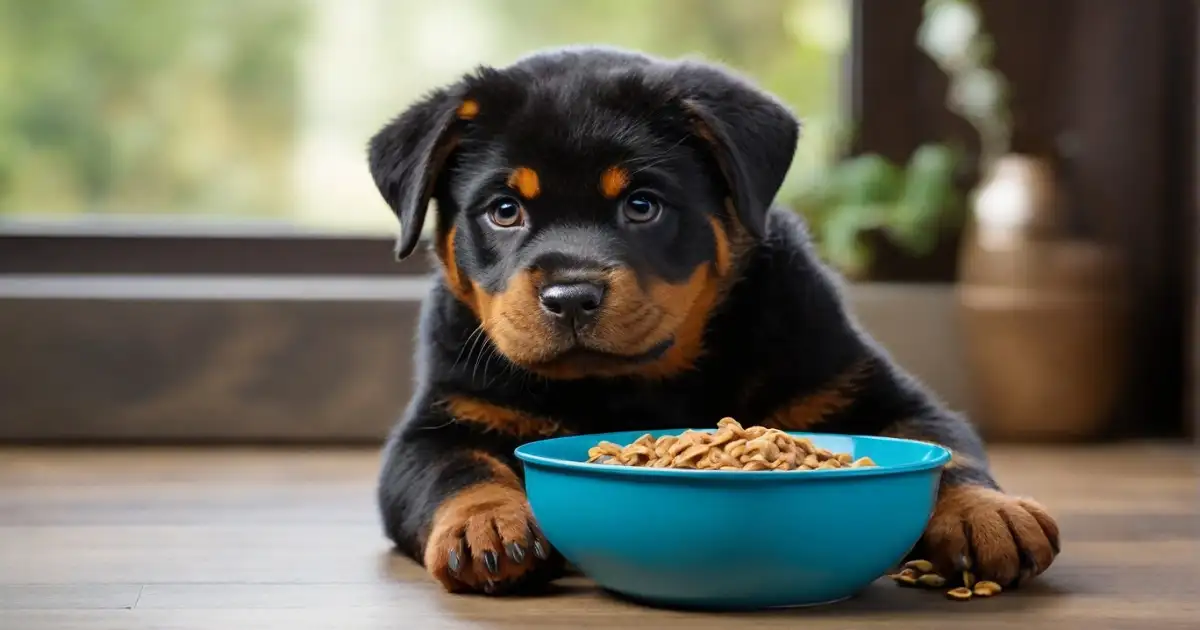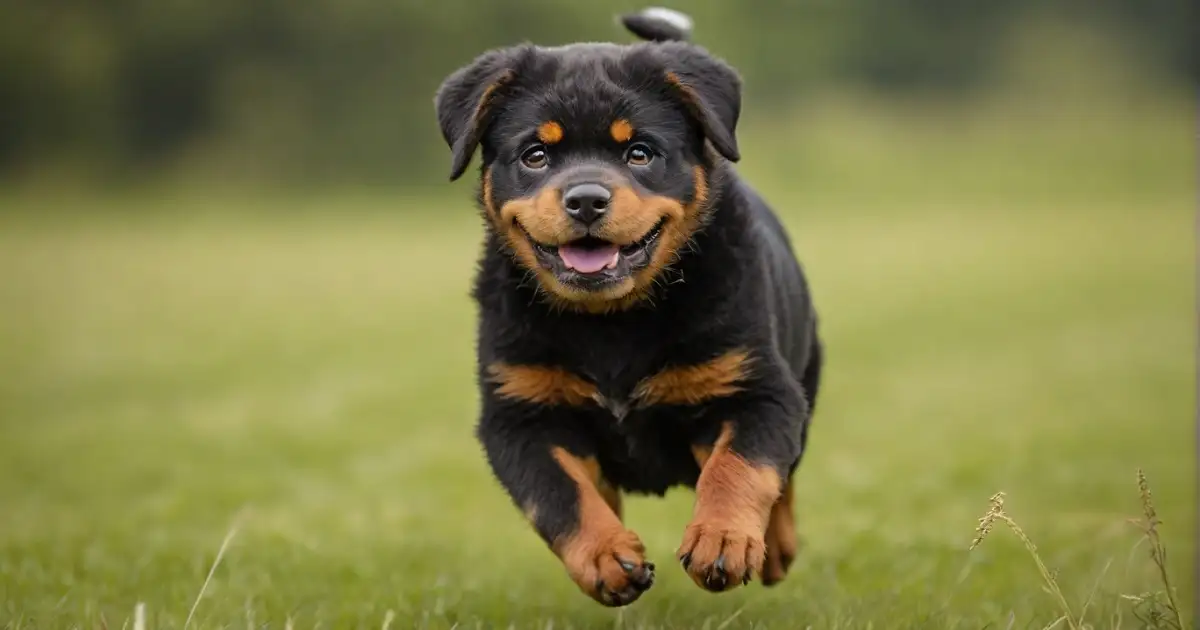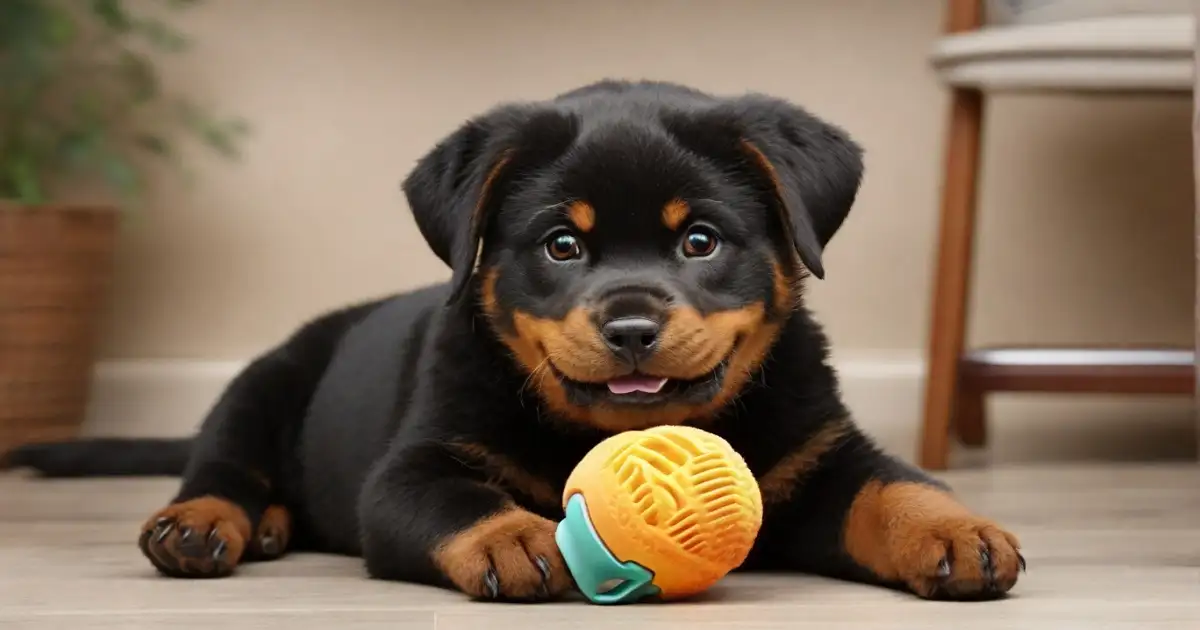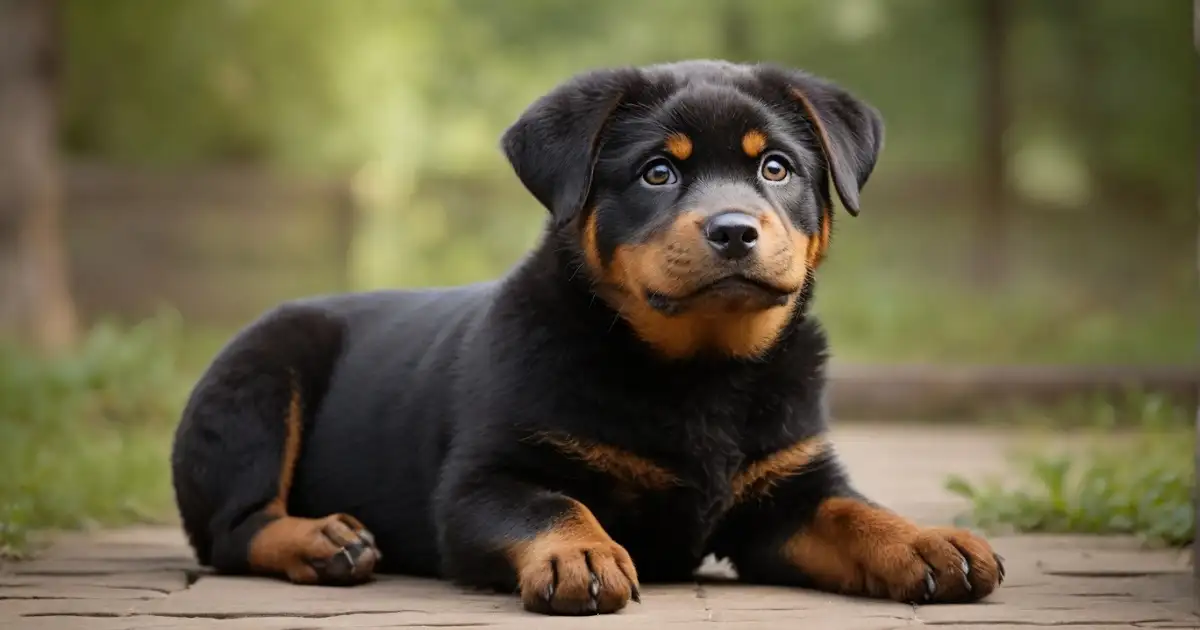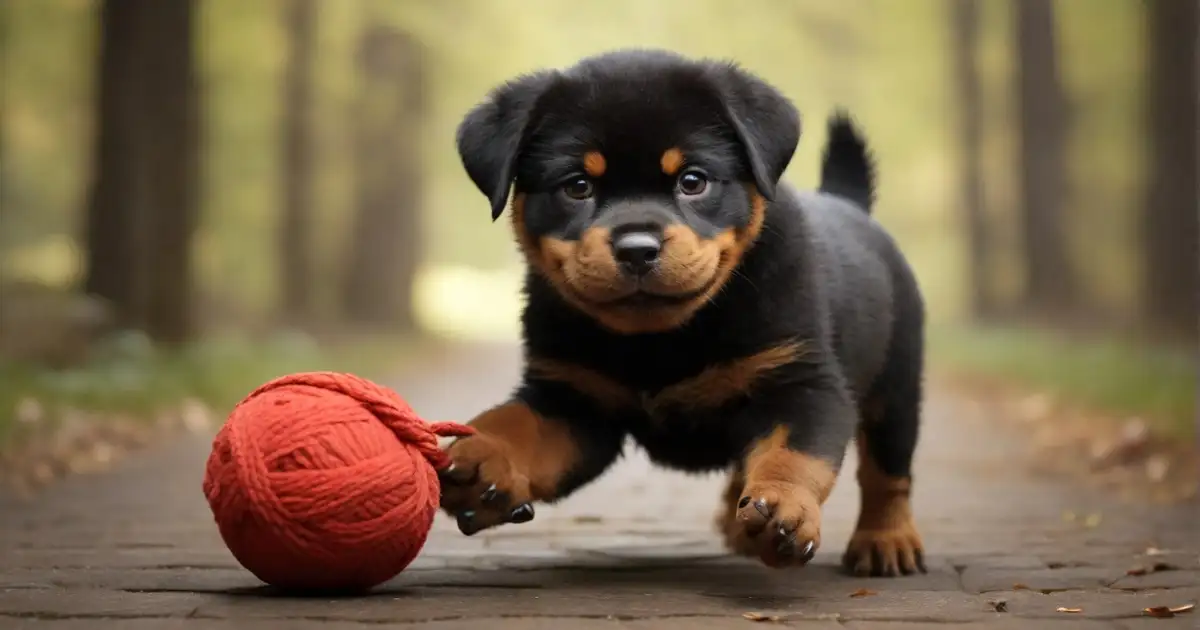As a new Rottweiler owner, nothing is more important than providing the right nutrition for your growing pup. At 9-month-old Rottweiler, your bundle of fur is rapidly developing and has specific dietary needs.
From puppyhood to adolescence, this transitional stage requires careful attention to ingredients like protein for building muscle and calcium for strengthening bones.
In this article, we’ll explore the unique nutritional requirements of Rottweiler puppies and how to meet them through feeding schedules, portion sizes, diet options, appropriate treats, and supplements.
Our goal is to empower you with the knowledge to optimize your 9-month-old’s nutrition during this formative phase. Equipped with these tips, you can nourish your Rottweiler puppy for a lifetime of health.
9-Month-Old Rottweilers
At 9 months old, Rottweiler puppies are right in the middle of some major developmental changes. No longer tiny fluff balls, 9-month-old Rottweilers have gained significant size and weight. But they still have a lot of growing left to do on their way to adulthood. This transitional stage deserves special attention and care.
Physical Development
The characteristic large, stocky frame of a Rottweiler really starts taking shape around 9 months old. Their rapid bone growth starts to slow down while muscle development accelerates. You’ll notice your puppy losing some of that lean, leggy look of adolescence.
Other physical milestones around 9 months include:
- Almost full adult height, around 22-27 inches tall
- Weight around 50-70 lbs on average
- Permanent teeth all erupted
- Improved coordination and balance
Make sure to monitor your 9-month-old Rottweiler’s diet closely at this age. They need quality nutrition to support their intense growth, but overfeeding, leading to obesity, is also a risk. Keep puppy vaccines up to date as immunity from mom wears off.
Mental Development
This period from 9-18 months old marks a fear stage for many Rottweiler puppies. They may become more timid or anxious in new situations. Socialization is especially important now to build their confidence. Keep exposing your 9-month-old Rottweiler to a wide variety of people, places, and other dogs in a positive way.
Mentally, your puppy has a shorter attention span but is ready to build on basic training. Work on commands like heel, stay, and come using positive reinforcement.
Don’t overdo long training sessions – keep them short and rewarding of their is also extremely food-motivated at this age. Use healthy treats to motivate them during training and provide interactive puzzle toys to stimulate their mind.
Adolescent Behavior
Along with the “teenage” fear stage, 9-month-old Rottweilers may start testing boundaries. Their natural instinct to guard resources like food, toys, and space may become more apparent.
Be patient and consistent, and avoid confrontations with your puppy. Redirect unwanted chewing or jumping with calm guidance. Make sure your Rottweiler pup gets plenty of exercise and playtime to burn off energy.
With your leadership, the behaviors of an adolescent Rottweiler can be channeled in a positive direction. Reward good conduct and correct unwanted actions fairly.
What to Expect Next
While every puppy develops differently, you can expect most Rottweiler puppies to fill out to their adult frame by 12-15 months old. As they mature, you will be able to gradually increase exercise duration as their joints toughen up. But avoid any high-impact activities until at least 18 months.
Around a year old, intact Rottweilers will reach sexual maturity. Floopy ears may finally stand erect. Their obedience training will become more refined and reliable as their focus improves.
By providing the very best care and nutrition during these formative months, you set your 9-month-old Rottweiler puppy up for a long, healthy life as your loyal companion.
Nutritional Needs of a 9-Month-Old Rottweiler
Proper nutrition is crucial for your 9-month-old Rottweiler during this rapid growth stage. While puppyhood is winding down, your dog still has specific dietary requirements to support their continued development.
Protein
Protein is essential for building strong muscles to support the large Rottweiler frame. Look for a puppy or adult food that contains at least 18-22% high-quality animal protein.
Sources: Chicken, beef, fish, eggs
Fat
Moderate fat levels around 12-15% provide concentrated energy for an active 9-month-old Rottweiler. Omega fatty acids also support skin, coat, and brain development.
Sources: Salmon, flaxseed, chicken fat
Carbohydrates
Complex carbs like whole grains give your pup the fuel to play and train. Limit simple sugars.
Sources: Brown rice, barley, sweet potatoes
Calcium
Proper calcium levels around 1.2% are crucial for bone growth and density. Excess calcium can be harmful.
Sources: Yogurt, cheese, bone meal
Fiber
A minimum of 5% fiber aids healthy digestion and nutrient absorption.
Sources: Veggies, bran, psyllium
Vitamins & Minerals
Complete puppy food will provide the right amounts of essential vitamins like A, B, C, D, and E. Important minerals include iron, zinc, copper, and selenium.
Feeding Amounts
The exact caloric needs of a 9-month-old Rottweiler depend on their weight and activity level. Here are some general guidelines:
- 50 lb puppy – 1000 calories per day
- 60 lb puppy – 1200 calories per day
- 70 lb puppy – 1400 calories per day
Divide this into 3-4 meals a day. Weigh and track growth weekly – adjust amounts as needed.
Feeding Schedule
At this age, transition your Rottweiler puppy to twice-daily feeding. For example:
- 7 AM – First feeding
- 5 PM – Second feeding
Keeping a consistent schedule will regulate your puppy’s hunger and bathroom habits.
Food Options
Choose a premium quality puppy or all-life stages food. Look for labels with meat as the first ingredient and natural preservatives. Here are some excellent options:
- Taste of the Wild High Prairie Puppy – Grain-free with bison, antioxidants and probiotics
- Wellness CORE Puppy – High protein kibble with probiotics and DHA
- Holistic Select Large & Giant Breed Puppy – Supports joint health with glucosamine
You can also discuss home-cooked or raw diets with your vet. Feeding a nutritionally balanced commercial diet is the easiest option for meeting all your 9-month-old Rottweiler’s dietary requirements.
Speak to your veterinarian if you have any questions about your puppy’s diet or growth. With the right nutrition now, you’ll set up your Rottweiler for a long, healthy life.
Exercise Needs for a 9-Month-Old Rottweiler.
Rottweilers are working dogs bred for jobs like herding, and they have high exercise needs. As your 9-month-old Rottweiler grows, it’s important to meet their activity requirements while protecting developing joints.
Energy Level
At 9 months old, your Rottweiler puppy is starting to leave the juvenile super-energy stage. Their intense growth rates mean they fatigue more easily. But they still need 60-90 minutes of active exercise daily.
Make sure your 9-month-old Rottweiler gets:
- 30 minutes of aerobic activity like running or swimming
- 30 minutes of mental stimulation through training, socializing, playing fetch
- 30 minutes of free play with canine buddies
Split this up into 2-3 sessions throughout the day. Interactive play is ideal for tiring out their body and mind.
Joint Protection
While your pup may act invincible, their joints are still vulnerable at this age. Growth plate closure generally happens between 12-18 months old.
To protect developing joints:
- Avoid high-impact activities like jumping until you are at least 18 months old
- Limit stair climbing or use a ramp instead
- Walk on soft surfaces like grass rather than concrete when possible
- Don’t overdo leash walks – keep them short with opportunities to rest
- Maintain a lean body weight to reduce joint stress
- Use joint supplements with glucosamine and chondroitin
Let your 9-month-old Rottweiler set the pace on walks and never force exercise. If they seem tired, it’s time for a break.
Mental Stimulation
Don’t forget brain games and training to tire out your Rottweiler’s brilliant mind. Useful ways to engage their thinking skills include:
- Advanced obedience work like heel and stay commands
- Food puzzles like frozen Kongs
- Hide-and-seek games
- Learning new tricks like crawling, spinning, or weaving through legs
- Socialization in novel environments
Training sessions should be kept short, 5-10 minutes, and always end on a positive note. Use play, praise, and treats to motivate your puppy.
What’s Next
Around 12 months old, you can increase aerobic exercise duration for your Rottweiler to 45-60 minutes as their endurance improves. But continue joint protection measures until at least 18 months old.
Adult Rottweilers require at least 2 hours of exercise per day. Building activity gradually helps ensure your growing puppy develops into a strong, healthy adolescent and adult dog. With patience and care now, you’ll have an active companion for years to come.
Training a 9-Month-Old Rottweiler
The key training goals for a 9-month-old Rottweiler are reinforcing obedience, socialization, and house manners. This adolescent stage is an important time for shaping your pup’s behavior.
Obedience
Keep working on basic commands like sit, stay, come, down, and heel with your 9-month-old Rottweiler. Formal training sessions should be 5-10 minutes long with lots of rewards. Practice commands during daily activities, too.
Important tips:
- Use a positive, upbeat tone to motivate your puppy
- Vary locations for training – don’t just practice at home
- Build duration for stay and heel commands through repetition
- Reward correct responses immediately with treats, toys, or praise
- End on a good note so your puppy looks forward to the next session
Avoid harsh corrections or punishment, which can damage your bond. Persistence and positivity are key!
Socialization
Frequent socialization helps build your 9-month-old Rottweiler’s confidence. Safely expose them to:
- New environments – parks, stores, car rides
- Other pets – dogs, cats, small animals
- People – kids, elderly, different ethnicities
- Noises – clapping, doorbells, cars
Go slowly and watch for signs of fear or anxiety. Pair new experiences with lots of treats and praise. Proper socialization prevents reactivity and aggression later on.
House Manners
Reinforce important house rules with your 9-month-old Rottweiler like:
- No jumping on people
- No mouthing hands or nipping
- No stealing food from counters or tables
- Waiting calmly for the food bowl to be put down
- Sitting politely at doors and gates before exiting
- Settling calmly rather than barking for attention
Be consistent so good manners become ingrained habits.
Gearing Up for Adolescence
The key to successfully training a 9-month-old Rottweiler is building engagement and motivation through fun, positive methods. Lay this foundation now before the more difficult adolescent phase hits at 12-18 months old. Be patient – your hard work will pay off with a polite, socialized companion for life!
Common Health Issues for a 9-Month-Old Rottweiler
Rottweilers are predisposed to certain health conditions. Being aware of risks specific to your 9-month-old Rottweiler allows you to monitor for signs and get prompt treatment if necessary.
Orthopedic Problems
Fast-growing large breed dogs like Rottweilers are prone to:
- Panosteitis – Bone inflammation causing limping. Usually resolves by 18 months old.
- Osteochondritis Dissecans – Elbow joint issue. It can cause lameness.
Limit exercise, use joint supplements, and avoid obesity to protect developing bones and joints.
Parasites
- Roundworms – Common worms that infect puppies. De-worm monthly.
- Giardia – Intestinal protozoa causing diarrhea.
Use preventatives and do fecal tests if diarrhea develops.
Heart Conditions
- Subvalvular Aortic Stenosis – Congenital heart defect. Causes fainting or sudden death in severe cases. Responsible breeders screen for this.
Monitor for signs of heart disease like fatigue or coughing. Catch issues early.
Bone Cancer
- Osteosarcoma – Aggressive bone cancer. Limb amputation and chemotherapy may help. Big dogs are more prone.
Check for any unusual lameness or swelling and report to your vet.
Eye Issues
- Entropion – Eyelids roll inward, irritating the eye. Requires surgical correction. More common in puppies.
- Ectropion – Eyelids sag outward. This leads to dry eye. Also often develops young.
Catch eyelid issues early to prevent vision damage.
Prevention
Protect your 9-month-old Rottweiler through:
- Routine vet exams
- Vaccinations
- Heartworm/flea/tick prevention
- High-quality diet
- Joint supplements
- Safe exercise
- Good dental care
Early recognition of problems in your Rottweiler puppy’s health can make treatment more successful. Be proactive!
Caring for a 9-Month-Old Rottweiler
Raising a Rottweiler puppy comes with big responsibilities. At 9 months old, your pup still requires attentive care and training to become a happy, well-adjusted companion.
Feeding
- Stick to a consistent, high-quality diet tailored for growth. Divide daily portions into two meals.
- Avoid overfeeding. Obesity stresses developing joints. Monitor weight weekly.
- Make the switch from puppy to adult food around 12 months old. Transition gradually over a week.
Exercise
-Aim for 30 minutes of aerobic exercise, 30 minutes of training games, and 30 minutes of free play daily. Break into multiple short sessions.
- Focus on positive reinforcement training to strengthen your bond during adolescent fear stages.
- Avoid high-impact exercise that stresses joints, like jumping or running on hard surfaces.
Grooming
- Brush coat 1-2 times per week to control shedding. Only bathe your dog when needed, using a mild dog shampoo.
- Trim nails every 2-3 weeks. Introduce dental care like tooth brushing.
- Check and wipe ears weekly. Clean as needed to prevent infections.
Health
- Keep up with the recommended puppy vaccine schedule until 16-20 weeks old.
- Give monthly heartworm, flea, and tick prevention medication.
- Have your vet do an exam during the 9-month visit to screen for potential issues.
- Spay or neuter your Rottweiler at around 12 months old unless you plan to breed.
Safety
- Properly crate train and/or dog-proof your home so your pup isn’t destructive when alone.
- Leash walk and supervise playtime in unfenced areas. Work on solid recall. Microchip your dog.
- Socialize carefully to prevent fearfulness or aggression towards strangers or other dogs.
Enrichment
- Provide interactive puzzle toys and rotate new ones regularly to engage their mind.
- Take training classes or try a dog sport like agility for fun mental and physical exercise.
- Teach new commands and positively reinforce wanted behaviors.
With diligent care in these areas during puppyhood, your 9-month-old Rottweiler will continue to blossom into an incredible companion.
What to Expect with a 9-Month-Old Rottweiler
Life with a 9-month-old Rottweiler puppy is always an adventure! This adolescent stage brings continued growth and big personality changes. Here’s what to expect from your pup.
Physical Changes
- Your puppy will reach nearly full adult height by 9 months, around 22-27 inches tall.
- Weight will range from 50-70 pounds on average. Their body will start filling out.
- You’ll notice improved coordination and balance as your Rottweiler pup begins losing that gangly look.
- Permanent teeth should all be erupted by now. Keep up with dental care.
- Appetite may fluctuate as growth rates shift. Stick to scheduled, portion-controlled feedings.
Mental Changes
- Attention span remains short, but focus improves with continued training.
- A “teenage” fear imprint stage emerges. Socialize carefully to build confidence.
- Resource-guarding tendencies may become more apparent. Use rewards to teach sharing.
- Your Rottweiler puppy becomes more independent-minded and tests boundaries. Be patient!
- Food motivation makes training easier, but watch weight gain. Use healthy treats.
Lifestyle Adaptations
- Supervise always or crate when you can’t watch your puppy. Chewing risk remains high.
- Be ready to increase exercise duration as endurance improves. But protect developing joints!
- Training will require more persistence and creativity during adolescent stubbornness.
- Patience is key as your puppy pushes boundaries and acts more “teenage.”
- Spend time bonding through play, cuddling, and engaging their smart mind.
What’s Next?
Over the next several months, your 9-month-old Rottweiler will continue developing into an adult dog. You can look forward to:
- Filling out of adult muscle tone and coat thickness
- Mellowing of energy levels
- Ears standing fully erect
- Reaching sexual maturity around 12 months
- Ongoing socialization and training challenges
- Transition to adult food around 12 months
Embrace this exciting puppy stage – soon, you’ll have a mature Rottweiler companion by your side!
Living with a 9-Month-Old Rottweiler
Life with a 9-month-old Rottweiler is active and engaging. This puppy-to-adolescent transition brings joy along with training challenges. Here’s how to be the best Rottweiler owner.
Exercise
- Plan on providing 60-90 minutes of exercise for your high-energy pup. This includes walking, playing, and training.
- Focus on low-impact activities and limit jumping or running on hard surfaces to protect developing joints.
- Make exercise fun with games of fetch, trips to new parks, and basic agility obstacles like tunnels or low hurdles.
- Ensure your pup gets plenty of off-leash playtime with canine friends for important socialization.
Training
- Continue reinforcing basic obedience commands like sit, stay, and down. Build duration and strengthen reliability.
- Challenge your Rottweiler pup’s mind by teaching new tricks and skills like weaving through your legs or carrying objects.
- Attend a group obedience class for socialization. Look for positive reinforcement methods.
- Work on proper leash manners to prevent pulling during adolescent enthusiasm.
Enrichment
- Provide puzzle toys stuffed with kibble or treats to occupy your puppy’s clever mind.
- Make mealtimes more engaging through food puzzle bowls, snuffle mats, and stuffed kungs.
- Offer new experiences like exposure to different sounds or car rides to new places. Socialize carefully.
Safety
- Puppy-proof your home by keeping shoes, remotes, cables, and other cchewableout of reach.
- Use baby gates, pens, or crates when you can’t actively supervise your Rottweiler. Adolescent chewing risk remains high.
- Properly ID your puppy with a collar, tag, and microchip in case they escape your yard. Reinforce recall training.
Living with a 9-month-old Rottweiler takes work but pays off exponentially in companionship. Be patient during training challenges, and enjoy watching your puppy grow!
Adopting a 9-Month-Old Rottweiler
If you’re looking to add an older Rottweiler puppy to your home, adopting a 9-month-old can be very rewarding. Here’s what you need to know.
Benefits of Adopting
There are many advantages to adopting an older 9-month-old Rottweiler puppy vs. an 8-week-old:
- Their personality is more developed, so it’s easier to match your lifestyle.
- You skip the puppy chewing and house training stage.
- Health and behavior issues may already be identified.
- Adolescent exercise needs are less than a young adult.
- You give a puppy in need a loving home!
Things to Consider
Keep in mind:
- Adopted puppies often lack complete health and genetic history. Be prepared for potential issues.
- Early socialization and training may be unknown. Work to identify and fill any gaps.
- Adolescent behaviors like testing boundaries may be in full force. Be patient!
- Rottweiler puppies are a long commitment – make sure you’re ready!
Finding Your New Pup
Great places to adopt a 9-month-old Rottweiler include:
- Rottweiler-specific breed rescues
- Local animal shelters
- Fosters who cannot permanently keep a litter puppy
Avoid pet stores or irresponsible online sellers. Always meet the puppy and family first when possible.
Bringing Pup Home
To set your adopted 9-month-old Rottweiler up for success:
- Puppy-proof your home by removing dangling wires, toxic plants, and medications. Supervise always.
- Stock up on appropriate food, bowls, collars, leashes, tags, crates, and toys.
- Child or dog-proof your yard with secure fencing and latches.
- Sign up for training classes and vet appointments.
- Give your new puppy time to decompress and bond with you before introducing it to other pets.
With preparation and patience, adopting an older Rottweiler puppy can be extremely fulfilling. You’ll experience all the fun of puppyhood while providing a forever home.
Conclusion
Caring for a Rottweiler puppy brings big responsibility. At 9 months old, Rocky is rapidly growing, and his dietary needs are incredibly important.
Jane now feels fully equipped to provide complete and balanced nutrition tailored to her puppy’s growth stage.
She understands the ideal amounts of protein, fat, calcium, and other nutrients required to fuel Rocky’s development and maintain optimal health. Jane is motivated to closely monitor Rocky’s intake, weight, and growth milestones, making adjustments as needed.
With her newfound knowledge, Jane will be able to navigate puppy food transitions, treat choices, supplements, and weight management for her 9-month-old Rottweiler.
Empowered with the expertise on Rottweiler puppy nutrition provided here, Jane can ensure Rocky’s lifelong health and happiness start with the right diet. With her diligent care and feeding, Rocky will continue to thrive as he matures into an adult dog.


